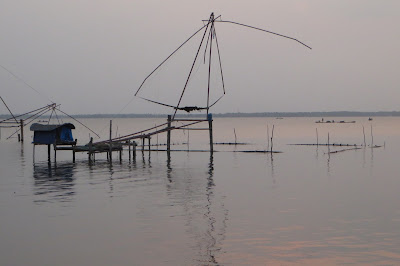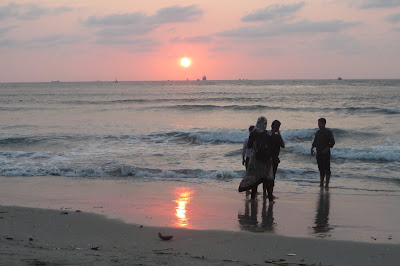 |
| Drying fish, Kerala, India |
You’ll find Kerala on the southwestern tip
of the Indian sub-continent. Legend has it that St. Thomas came evangelizing in
52 CE, but historical evidence favors the Portuguese who formed an alliance
with the local king and built a fort at Cochin (now called Kochi) in 1503.
 |
| Our three guides |
The spice trade, for which Kerala is still
famous, lured the Europeans and today 18% of the population is Christian, 27%
Muslim, and 55% Hindu. We had three guides on our cycling trip: Joseph is
Christian, Shibu is Muslim, Hari is Hindu. They are the best of friends.
 |
| Sunset, Nilgiri Hills |
When we descended the Nilgiri hills into
Kerala we came to the Arabian Sea which brought cooling breezes to a tropical
landscape. That afternoon we went swimming in the sea. It was windy and choppy, but as warm as a
bath. Fishermen still ply their trade in traditional wooden boats, but powered
with motors, not sails.
 |
| Fishing Net |
We followed Joseph on a winding route of
narrow lanes, passing grand homes built by Indians who work in the Gulf States
and elsewhere. (Joseph’s wife, a nurse, has worked in Saudi Arabia for three
years.) Then into the countryside, stopping for a festival parade of dancers
and musicians, and on to the old harbor area of Kochi.
 |
| Festival dancers |
Cycling down narrow alleyways we reach a
private home, climb to a roof terrace and are served a dozen courses of delicious
Keralan specialties served on a banana leaf. I eat it all with my right hand, local
style. After that we retreat to the shady garden of our British-era guest house
to rest and digest!
 |
| Resting at our guest house |
A free day in Kochi sends me shopping with
friends. We fill my extra duffel bag with carpets, wall hangings, silk tunics,
and spices.
 |
| Kathakali actors |
We attend a short tourist version of a Kathakali dance, arriving
early to watch actors apply their elaborate colorful makeup. Traditional
performances last from dusk until dawn, with many actors dramatizing familiar
legends. Kathakali plays are accompanied by percussion but no words. Actions
and emotions are expressed by stylized movement, hand gestures (mudras) and
very expressive faces. We saw a two-person story of a failed seduction which
ended badly for the heroine (offstage).
 |
| Sunset over the Arabian Sea in Kerala |
Along with the locals, we watch the sun set
over the sea. Next day, we’re back on the bikes to meet our next adventure: an
overnight cruise on the backwaters of Kerala.
 |
| Tour map |
Cycling
distances on this trip varied from 12-55 miles/day, averaging about 30
miles/day. Road conditions were good, most rides were on quiet back roads. Van
support was always available for those who chose not to cycle. See www.exodustravels.com for more information on this and other
tours.
 |
| Saris drying in the sun |
Selected bibliography:
The
God of Small Things by Arundhati Roy. This 1997
Booker-prizewinning novel takes place in Kerala.
The End
of Karma: Hope and Fury Among India’s Young by Somini Sengupta. A New York Times
reporter, born in India and raised in the U.S., spent several years researching
this 2016 book about India today.
Kim
by Rudyard Kipling. Story of a street orphan and
Tibetan lama in 1890s India: a spy thriller, social commentary, and poignant
coming of age story. One of my favorite classics.
Note: Go to Gretchen's posts on this blog on 4/17/2017 and 4/24/2017 for parts 1 and 2 of her South India cycling trip.




























